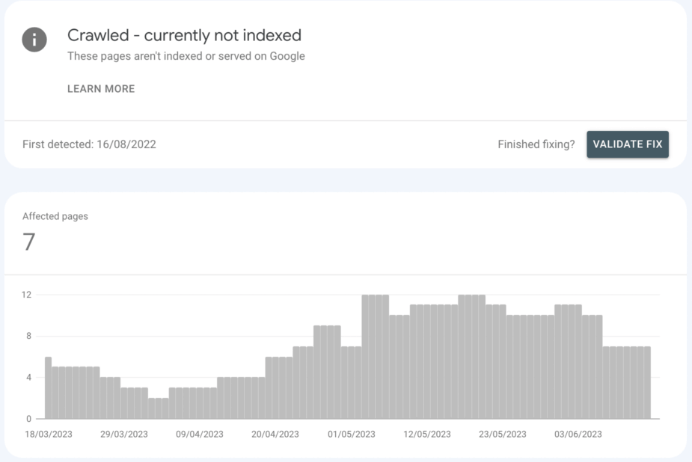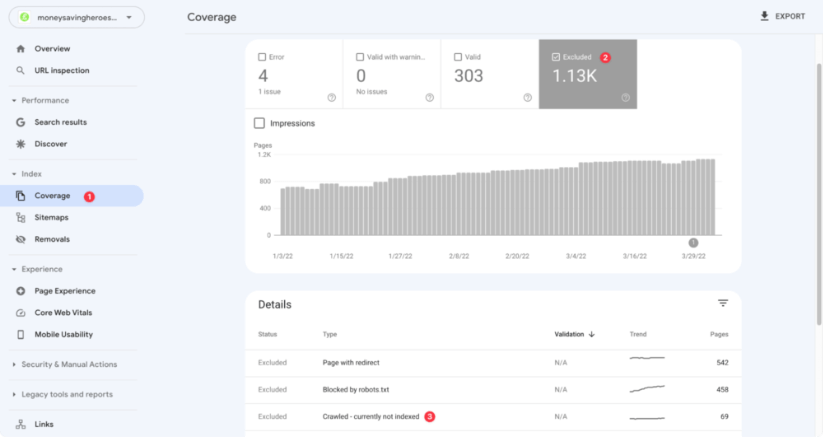Crawled – currently not indexed is an excluded status used in Google Search Console. It’s used to denote that Google has crawled a page but decided not to index it. This means the URL will not appear on the SERPs.
Google doesn’t clarify why a page gets this status. But we know these pages often receive this status when Google views a page as low-quality. This article will focus on how to fix the Crawled – currently not indexed GSC error code. This article is part of our Google Search Console tutorials and training section. Be sure to check the other articles out.

What does the Crawled – currently not indexed status mean?
The Crawled – currently not indexed status means one thing. Google has crawled your page but decided not to index it. This means the page will not show up on Google’s SERPs. For any query. There could be many reasons for this. We will discuss this later.
How to fix the Crawled – currently not indexed status
Below is a list of common issues causing pages Google may list as Crawled – currently not indexed. We have also listed what possible solutions you can use to make Google index them. It’s worth noting the Crawled – currently not indexed error is different to another error. The Excluded by ‘Noindex’ tag error. Say you have two pages with these errors. Google has crawled both, and chosen not to index them. But the Crawled – currently not indexed error is open to more interpretation.
Improve internal linking
Google may skip indexing a page due to poor internal link structure or absence of links. We call pages without any incoming links orphan pages. To resolve the Crawled – currently not indexed status, improve internal linking. You can improve your internal linking by:
- Finding an existing page on your site that ranks well.
- Identifying sections that relate to your non-indexed page topic.
- Adding relevant links from these pages to your non-indexed content.
You can also find internal linking opportunities through this Google search modifier: Site:yourdomain.com ‘target keyword of non-indexed page’ This search finds pages on your site that mention your target keyword. Making perfect candidates to link to your non-indexed page content. Internal linking signals to Google the importance and relevance of site content. This fix takes minutes to do. But it can transform pages from Crawled – currently not indexed to indexed.
Thin content / low-quality content
Pages with few words lack information Google wants. Google crawls these pages but keeps them out of search results. Thin content happens when your page has fewer words than top competitors. If top pages have 3000+ words, your 300-word page faces problems. If top results show mixed lengths, your shorter page might still work. Fix this issue by adding more valuable information. Cover the topic but stay concise. Google rewards helpful content that answers user questions completely. Google won’t tell you about thin content problems. Check competing pages yourself. Use your judgment to decide how much to write for your Crawled – currently not indexed pages.
Search intent
Search intent mismatch can cause Google to crawl but not index pages. This happens when your content differs from what users expect to find. Look at this example: For “how to calculate taxes.” Google shows calculators, videos, and guides. You can succeed with different formats. But for “tax calculator,” a tool works better than an article. Check first-page Google results before creating content. This shows what content type Google prefers. To fix Crawled – currently not indexed pages, rewrite or replace your content to match the intent.
Page with near-duplicate content
Google uses its resources well. Google avoids indexing duplicate content. John Mueller confirms no penalties exist for duplicate content. But Google still won’t index it. Pages with duplicate content often get the “Crawled – Not Indexed” label. Duplicate content happens in these cases:
- Ecommerce sites with similar product variations
- Sites with lots of user content
- Pages covering similar topics
Google filters duplicate pages to improve user experience. Check your Performance report. See what pages already rank for your target keyword. For similar content pages, add a canonical tag. This tag tells Google which page to index. Google usually follows canonical tags. If your pages differ enough, change the content on one page. Make each page unique to avoid the Crawled – currently not indexed status.
Mismatches in structured data
Structured data helps search engines understand your content. Check your structured data status in Google Search Console Enhancements tab. Check your structured data. Errors can cause Google to refuse indexing pages after crawling them. Product pages often face this issue. Structured data errors confuse Google about your page content. This prevents rich snippets and sometimes blocks indexing completely. Warnings differ from errors. Pages with warnings may still get indexed but might miss rich snippet opportunities. Fix structured data problems. This will help move pages from Crawled – currently not indexed to indexed.
Out-of-stock or expired products
A common problem on ecommerce sites involves product pages. These pages often show as Crawled – currently not indexed. Usually, this comes down to out-of-stock products. Google checks product availability during crawls. When products are unavailable, Google notices. Then it marks them as Crawled – currently not indexed. This approach prioritizes user experience. Google avoids showing unavailable products in search results. For ecommerce sites with this indexing issue, check your stock feed. Ensure available products display correct status on pages. After fixing availability issues, request Google recrawl these URLs. John Mueller from Google gives some guidance on this.
301 redirects
This problem is rare on large, trusted sites that Google crawls lots. But it can still occur. We sometimes find redirect destination URLs in our Page Indexing Report. Showing the Crawled – currently not indexed status. This happens not from bad redirects but from how fast Google crawls your site. Google crawls the destination URL but excludes it from the index. Check the SERP to identify this issue. Fix this problem with a temporary sitemap file. Follow these steps:
- Get all URLs from the Crawled – currently not indexed report
- Match them with your redirects in Excel or Google Sheets
- Create a sitemap using ScreamingFrog
- Upload this sitemap to Google Search Console
This method helps Google understand and index your redirected pages. Helping to resolve the Crawled – currently not indexed status.
Private or gated content

Googlebot sometimes accesses content it should not see. This creates Crawled – currently not indexed errors on private URLs. Private pages include development sites, login-protected pages, paywalled content, and more. This happens when Google crawls without focus. Googlebot explores every accessible area searching for valuable content. Fix this issue with these steps:
- Run a website crawl using ScreamingFrog or Sitebulb
- Create a list of pages that should remain private
- Choose the best protection method:
- Remove internal links to these pages
- Delete them from your sitemap
- Update your robots.txt file to block Googlebot from these sections
These actions prevent private content from appearing as Crawled – currently not indexed. And protects sensitive information from public exposure!
Other factors leading to Crawled – currently not indexed errors
False positives
A false positive occurs when GSC marks a page as excluded, but it appears in the index. This creates confusion in coverage reports. Test if you have a false positive:
- Go to Google.com
- Type your full page URL as the search query
- Check if your page appears in results
When your page shows in SERPs despite a Crawled – currently not indexed status code. This is when you know you have a false positive. This situation requires no action. The issue exists only in Search Console reporting, not in actual Google indexing. Focus your time on fixing real indexing problems rather than these reporting errors.
Paginated URLs
Blogs and online shops use pagination to organize content. Paginated URLs contain page numbers at the end like www.myDomain.com/blog/page/2. Google often chooses not to index these paginated pages. This creates Crawled – currently not indexed reports. Before trying to fix this issue, ask: Do these paginated pages need indexing? Will they rank for valuable keywords? Review Google’s pagination best practices. Or read pagination SEO guides to make informed decisions. Fix only paginated pages that provide unique value to search users.
RSS feed URLs
RSS feeds are helpful for content distribution. But these URLs aren’t meant for humans. If Google crawls but doesn’t index your RSS feeds, there is nothing to fix. You shouldn’t worry if this is the case.
Crawled – currently not indexed vs Discovered – currently not indexed
These two statuses look similar but have one major difference. Discovered – currently not indexed means Googlebot found your URL but did not crawl it. This happens due to robots.txt restrictions or other factors. Crawled – currently not indexed means Googlebot visited and analyzed your page but chose not to add it to the search index. This happens for the specific reasons we explained in previous sections. The distinction matters for troubleshooting. The first status requires fixing discovery issues. The second status needs content quality improvements. Identify which status affects your pages to apply the correct solution.
Crawled – currently not indexed FAQs
Is the Crawled – currently not indexed status classed as an error?
No. Crawled – currently not indexed represents an excluded status from search results. The need for action depends on your investigation results. Check internal linking, content quality, and other issues discussed in our guide to determine proper fixes.
Where do I find instances of Crawled – currently not indexed pages?
Find pages with Crawled – currently not indexed status in the Google Search Console Coverage report under the Excluded tab.

Why are my pages not being indexed on Google?
Google might not index your pages for many reasons. Take these steps to improve indexing chances:
- Use the URL inspection tool in Google Search Console to check if indexing is possible
- Follow the specific fixes outlined in our guide sections above
Can pages with redirects be marked as Crawled – currently not indexed?
No. Google Search Console uses a separate excluded status for redirected pages. Keeping them distinct from Crawled – currently not indexed. John Mueller confirmed on Twitter (now X) that Google does not index pages with redirects.

